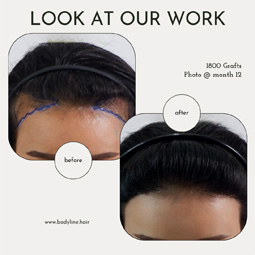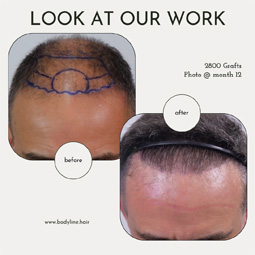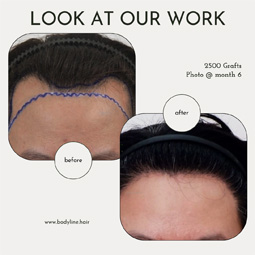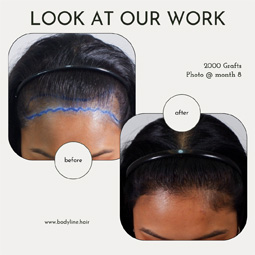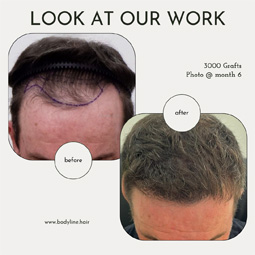Hair loss is a common problem that affects millions of people worldwide. It can be caused by a variety of factors, including genetics, stress, and medical conditions. For those who are experiencing hair loss, hair transplants are a popular treatment option. But what is the success rate of hair transplants? In this article, we will explore the success rate of hair transplants and what factors can affect it.
What is a Hair Transplant?
A hair transplant is a surgical procedure that involves moving hair follicles from one part of the body (usually the back or sides of the head) to the balding or thinning areas. This procedure is typically used to treat male pattern baldness, but it can also be used to restore hair in other areas of the body, such as the eyebrows or beard.
Types of Hair Transplants
There are two related types of hair transplants that our surgeons at Bodyline focus on: follicular unit extraction (FUE) and follicular unit implantation (FUI).
FUE Hair transplants involves extracting individual hair follicles directly from the donor area and transplanting them into the recipient area. This method leaves no linear scar.
FUI Hair Transplant uses the extraction method of FUE Hair Transplants and combines it with the Implanter Tool made famous by Direct Hair Implantation (DHI). In essence FUI equals FUE Hair Transplants plus DHI Hair Transplants (FUI = FUE + DHI).
What is the Success Rate of Hair Transplants?
The success rate of hair transplants can vary depending on several factors, including the type of transplant, the skill of the surgeon, and the individual’s overall health. However, on average, the success rate of hair transplants is around 85-98%.
Follicular Unit Implantation (FUI):
- Survival rate: Typically between 90-98%, meaning at least 90% of the transplanted follicles should successfully grow new hair.
- Natural-looking results: Achieved due to the follicular units containing multiple hairs for a denser appearance.
- Potential downside: Is generally more expensive due to the additional time needed to complete procedure when compared to FUE Hair Transplant.
Follicular Unit Extraction (FUE):
- Survival rate: Slightly lower than FUI, often ranging from 85-95%.
- Minimal scarring: No linear scar, just tiny punch marks that heal quickly and leave minimal visibility.
- Potential downside: Can be slower recovery due to the shaving of the hair that is required to harvest the grafts and implant them in the appropriate areas.
It’s important to remember that “success” in hair transplants isn’t always just about pure follicle survival. Ultimately, it’s about achieving a natural-looking outcome that meets the patient’s expectations. Factors like:
- Density and coverage: Does the transplanted hair provide adequate density and cover the baldness effectively?
- Hairline design: Does the hairline appear natural and suit the patient’s facial features?
- Overall aesthetics: Does the overall result look natural and aesthetically pleasing?
These factors also contribute to a successful hair transplant, and a skilled surgeon will consider them alongside the follicle survival rate.
Important note: The statistics mentioned above are general estimates and don’t guarantee individual results. Always consult with a qualified hair transplant surgeon who can assess your specific case and provide a realistic expectation of success based on your unique situation.
Factors That Can Affect the Success Rate
Type of Transplant
The type of hair transplant used can have an impact on the success rate. FUI Hair Transplant has a slightly higher success rate compared to FUE Hair Transplant, as it involves extracting individual hair and then implanting them with the DHI Implanter Tool. This method also has a lower risk of complications and a shorter recovery time.
Skill of the Surgeon
The skill and experience of the surgeon performing the hair transplant can also affect the success rate. It is essential to choose a qualified and experienced surgeon who has a good track record of successful hair transplants.
Individual’s Health
The overall health of the individual can also play a role in the success rate of a hair transplant. Those with underlying medical conditions or a weakened immune system may have a lower success rate. It is crucial to discuss any health concerns with the surgeon before undergoing a hair transplant.
What Can You Expect After a Hair Transplant?
After a hair transplant, it is normal to experience some swelling, redness, and scabbing in the recipient area. This is a natural part of the healing process and should subside within a few days. The transplanted hair may also fall out within the first few weeks, but this is also normal. The hair follicles will then enter a resting phase before new hair growth begins.
Timeline of Hair Growth After a Hair Transplant
- 3-4 months: New hair growth will start to appear, but it may be thin and fine at first.
- 6-9 months: The transplanted hair will continue to grow, and the density will increase.
- 12-18 months: The full results of the hair transplant should be visible at this point.
How to Improve the Success Rate of a Hair Transplant
While the success rate of hair transplants is high, there are some steps you can take to improve the chances of a successful outcome.
Choose a Qualified Surgeon
As mentioned earlier, the skill and experience of the surgeon can have a significant impact on the success rate of a hair transplant. It is crucial to do your research and choose a qualified and experienced surgeon who has a good track record of successful hair transplants.
Follow Post-Operative Care Instructions
Following the post-operative care instructions provided by your surgeon is crucial for a successful hair transplant. This may include avoiding strenuous activities, keeping the recipient area clean, and taking any prescribed medications.
Maintain a Healthy Lifestyle
Maintaining a healthy lifestyle can also improve the success rate of a hair transplant. This includes eating a balanced diet, getting enough sleep, and managing stress levels. These factors can all contribute to the overall health of your hair and promote successful hair growth after a transplant.
Conclusion
Hair transplants have a high success rate and can significantly improve the appearance of thinning or balding hair. The type of transplant, the skill of the surgeon, and the individual’s overall health can all affect the success rate. By choosing a qualified surgeon, following post-operative care instructions, and maintaining a healthy lifestyle, you can improve the chances of a successful hair transplant. If you are considering a hair transplant, be sure to consult with a qualified surgeon to determine if it is the right option for you.
The success rate of hair transplants depends on several factors, including the technique used, the surgeon’s skill, and the patient’s individual characteristics. However, in general, both FUT and FUE techniques can boast high success rates:
Follicular Unit Transplantation (FUT):
- Survival rate: Typically between 90-98%, meaning at least 90% of the transplanted follicles should successfully grow new hair.
- Natural-looking results: Achieved due to the follicular units containing multiple hairs for a denser appearance.
- Potential downside: Linear scar on the donor area, though generally hidden by existing hair.
Follicular Unit Extraction (FUE):
- Survival rate: Slightly lower than FUT, often ranging from 85-95%.
- Minimal scarring: No linear scar, just tiny punch marks that heal quickly and leave minimal visibility.
- Potential downside: Can be slower and more expensive than FUT due to individual follicle extraction.


